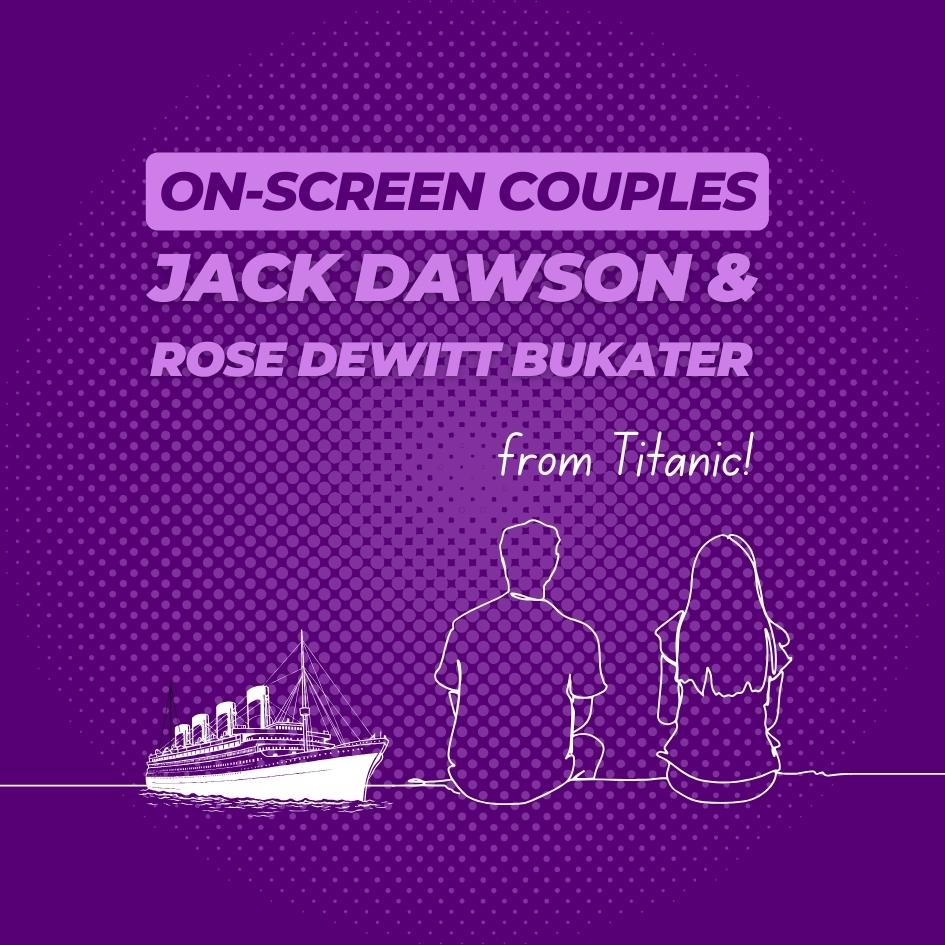When it comes to cinematic love stories, few have seized the collective imagination quite like the tale of Jack Dawson and Rose DeWitt Bukater from James Cameron’s Titanic. Released in 1997, this monumental film not only etched an indelible mark on the hearts of its audience but also redefined the boundaries of epic filmmaking. At the heart of Titanic’s narrative lies the poignant love story between Jack, a penniless artist with a heart full of dreams, and Rose, a young woman from the upper echelons of society, trapped in a life she did not choose. Their story, set against the tragic backdrop of the RMS Titanic’s ill-fated maiden voyage, explores themes of love, class, and the human spirit’s indomitability in the face of disaster.
did not choose. Their story, set against the tragic backdrop of the RMS Titanic’s ill-fated maiden voyage, explores themes of love, class, and the human spirit’s indomitability in the face of disaster.
As viewers, we are whisked away on a journey that transcends time, class, and ultimately, life itself. The characters of Jack and Rose, portrayed with compelling depth and vulnerability by Leonardo DiCaprio and Kate Winslet, became more than just fictional creations; they became symbols of eternal love, resilience, and the struggle against societal constraints. This article aims to delve into the making of these iconic characters, the narrative arc of their relationship, and the lasting impact their story has had on popular culture and the collective memory of the Titanic disaster. Join us as we explore the timeless love story of Jack and Rose, a tale that continues to captivate and inspire millions around the globe.
The Making of Jack and Rose
At the heart of James Cameron’s Titanic lies the unforgettable love story of Jack Dawson and Rose DeWitt Bukater, characters who, despite their fictional status, have become emblematic of true love’s power to transcend societal boundaries and even life itself. The creation of these characters was a meticulous process, blending historical research with Cameron’s imaginative storytelling to craft a narrative that would resonate deeply with audiences worldwide.
Inspiration and Character Development
James Cameron, known for his attention to detail and passion for the Titanic’s history, envisioned a love story that would serve as the emotional backbone of the film. He sought to create characters that embodied the human spirit, with all its flaws and grandeur, set against the backdrop of the Titanic’s tragic voyage. Jack Dawson emerged as the epitome of freedom and aspiration, a young artist who wins his passage on the RMS Titanic in a lucky poker game. Rose DeWitt Bukater, on the other hand, was conceived as his counterpoint: a woman of society, engaged to a wealthy man, yet suffocated by the constraints of her class and the expectations placed upon her.
Casting Leonardo DiCaprio and Kate Winslet
The casting of Jack and Rose was crucial to the film’s success. Leonardo DiCaprio, with his boyish charm and formidable talent, was cast as Jack Dawson. DiCaprio brought a sense of adventure, optimism, and vulnerability to Jack, making audiences worldwide root for him from their first glimpse. Kate Winslet’s portrayal of Rose DeWitt Bukater was equally pivotal. Winslet, known for her depth and range as an actress, captured Rose’s transformation from a constrained young woman to one who embraces her agency and desires. The chemistry between DiCaprio and Winslet was palpable, lending authenticity and depth to their characters’ relationship.
Character Dynamics and Themes
Jack and Rose’s relationship was designed to challenge and explore themes of love, freedom, and societal constraints. Cameron used their love story as a lens through which to view the broader human experiences of hope, rebellion, and the search for self-identity amidst the rigid class divisions of the early 20th century. Their interactions, from their meet-cute to their final, heartbreaking moments, were crafted to highlight the stark contrasts and ultimately, the profound connections between their worlds.
Through their journey, Cameron not only narrated a love story but also critiqued the societal norms that dictated the lives of individuals during the Titanic era. Jack and Rose’s love story, thus, became a narrative vehicle for exploring themes of class disparity, personal freedom, and the human capacity for love and sacrifice.
The making of Jack and Rose was a testament to James Cameron’s vision and the talents of Leonardo DiCaprio and Kate Winslet. Together, they brought to life characters that have become cultural icons, symbolising eternal love and the indomitable human spirit. Their story remains a poignant reminder of the power of cinema to evoke empathy, inspire dreams, and immortalise the human experience against the backdrop of historical events.
The Love Story That Captivated Millions
At the core of James Cameron’s Titanic is a love story so profound and moving that it has captivated millions of viewers across the globe. The relationship between Jack Dawson and Rose DeWitt Bukater transcends the boundaries of their societal classes, the confines of the RMS Titanic, and even the passage of time, becoming a testament to the enduring power of love.
A Meeting of Two Worlds
The serendipitous meeting of Jack and Rose aboard the Titanic serves as the catalyst for one of cinema’s most memorable love stories. Jack, a free-spirited artist with nothing to his name but his dreams, and Rose, a young woman suffocating under the weight of societal expectations and an impending loveless marriage, find in each other a kindred spirit. Their romance begins with stolen glances and clandestine meetings, blossoming against the backdrop of the luxurious yet imprisoning confines of the Titanic.
Defying Social Norms
Their love story is not just a personal journey but a bold defiance of the era’s rigid social norms. Jack and Rose’s relationship challenges the class divisions that were starkly evident on the Titanic, symbolising hope and change. Through their love, they create a world where barriers of class and status fall away, revealing the essence of true connection and mutual respect. This narrative of love transcending societal boundaries resonated deeply with audiences, reminding them of love’s power to challenge and overcome obstacles.
Iconic Moments
Certain moments in Jack and Rose’s story have become iconic, etched into the collective memory of cinema audiences. The scene at the ship’s bow, where Jack and Rose stand together, arms outstretched as if they could fly, encapsulates the freedom and exhilaration of their love. Similarly, their dance in the third-class quarters showcases their rejection of societal norms in favour of genuine joy and connection. These moments, among others, underscore the depth of their bond and the strength of their defiance against the world.
A Tragic Yet Timeless Conclusion
The tragic ending of their story, with the sinking of the Titanic, brings a poignant conclusion to their brief yet intense relationship. Jack’s ultimate sacrifice, ensuring Rose’s survival, epitomises the selfless nature of true love. This act of love, set against the disaster that claimed over 1,500 lives, serves as a powerful reminder of the human capacity for sacrifice and resilience.
Legacy and Impact
The love story of Jack and Rose has left an indelible mark on the hearts of viewers. It has become a cultural touchstone for discussions about love, destiny, and the human spirit’s resilience. Their story, while set in a specific historical context, speaks to universal themes of love’s transformative power, the fight against societal constraints, and the pursuit of personal freedom.
Behind the Scenes: Bringing Jack and Rose to Life
The creation of Titanic’s unforgettable love story between Jack Dawson and Rose DeWitt Bukater was not just a product of excellent scriptwriting and direction; it was also the result of the dedication, chemistry, and talent of the cast and crew who worked tirelessly behind the scenes. This section delves into the efforts and challenges faced in bringing Jack and Rose’s story to life, offering a glimpse into the magic of filmmaking that captivated millions.
Chemistry and Challenges
Leonardo DiCaprio and Kate Winslet’s on-screen chemistry was pivotal in making Jack and Rose’s love story believable and compelling. From their first screen test, it was evident that the pair shared a special bond, crucial for portraying the depth of Jack and Rose’s relationship. However, bringing this chemistry to life was not without its challenges. The filming of Titanic was notoriously gruelling, with long hours in cold water and physically demanding scenes. Yet, it was DiCaprio and Winslet’s commitment to their roles and their mutual support that helped them overcome these challenges, creating memorable performances that resonated with audiences worldwide.
Creating Authentic Moments
Director James Cameron was determined to ensure that every scene between Jack and Rose felt authentic and true to the time period. This commitment to authenticity extended to the meticulous set design, costumes, and dialogue, all carefully crafted to reflect the era’s social norms and the Titanic’s luxury. The famous “I’m flying” scene at the ship’s bow, for instance, required careful coordination and technical expertise to safely execute, yet it’s the raw emotion and connection between the characters that leave a lasting impact on the viewer.
Anecdotes from the Set
Behind the scenes, the filming of Titanic was filled with moments that contributed to the film’s legacy. Kate Winslet, ever committed to her role, insisted on performing many of her stunts without a wetsuit, leading to her contracting hypothermia. Leonardo DiCaprio, meanwhile, brought levity and warmth to the set, even as he tackled some of the most physically demanding scenes. The camaraderie among the cast and crew, faced with the enormity of recreating one of history’s greatest maritime disasters, fostered a sense of unity and purpose that translated onto the screen.
A Director’s Vision
James Cameron’s vision for Titanic was not just to recount the tragic sinking of the ship but to humanise the disaster through the lens of Jack and Rose’s love story. Cameron’s hands-on approach to directing, his attention to detail, and his dedication to storytelling were instrumental in bringing this vision to life. It was his ability to balance historical accuracy with compelling narrative that made Titanic a cinematic masterpiece.
Cultural Impact and Legacy
The love story of Jack Dawson and Rose DeWitt Bukater, set against the tragic backdrop of the RMS Titanic’s ill-fated voyage, has left an indelible mark on popular culture and cinema. James Cameron’s Titanic, released in 1997, not only achieved monumental success at the box office but also captivated the hearts of audiences around the world, cementing its place in the annals of film history. The cultural impact and legacy of Jack and Rose’s story extend far beyond the immediate success of the film, influencing fashion, language, and the way love stories are portrayed in cinema.
A New Standard for Love Stories
Jack and Rose’s romance set a new benchmark for love stories on the silver screen. Their relationship, characterised by its depth, passion, and defiance of social norms, resonated with viewers, offering a template for epic love stories that followed. The film’s success demonstrated the audience’s appetite for narratives that combine historical context with deeply personal, emotional journeys. It paved the way for future films to explore complex relationships against the backdrop of significant historical events, blending fact with fiction to create compelling cinema.
Influence on Popular Culture
Titanic’s influence extended beyond the cinema into popular culture, inspiring a renewed interest in the history of the Titanic itself. The film’s iconic scenes, quotes, and music became part of the cultural lexicon, referenced in television shows, music, literature, and internet memes. The phrase “I’m the king of the world!” shouted by Jack as he stands at the bow of the ship, became synonymous with feelings of triumph and freedom. Similarly, the image of Jack and Rose at the ship’s bow, arms outstretched, has been recreated countless times, symbolising eternal love and freedom.
Fashion and Artistic Inspiration
The film also had a significant impact on fashion, with Rose’s elegant Edwardian wardrobe inspiring fashion designers and enthusiasts alike. The resurgence of 1910s fashion trends, including corsets, lace, and beaded gowns, can be attributed in part to the film’s influence. Moreover, the story of Jack and Rose has inspired countless works of art, music, and literature, reflecting the universal appeal of their love story and the tragedy of the Titanic.
Legacy in Film and Society
Titanic’s legacy is also evident in its continued relevance more than two decades after its release. It remains a benchmark for cinematic achievements in storytelling, special effects, and production design. The film’s ability to evoke a wide range of emotions, from the exhilaration of love to the despair of loss, speaks to its mastery of the cinematic form. Moreover, the story of Jack and Rose has become a cultural touchstone for discussions about class disparity, the human condition, and the enduring power of love.
The Real Titanic vs Fictional Love
James Cameron’s Titanic masterfully intertwines the poignant love story of Jack Dawson and Rose DeWitt Bukater with the historical tragedy of the RMS Titanic, creating a cinematic experience that is both emotionally compelling and historically evocative. While the romance between Jack and Rose captures the hearts of audiences, it is juxtaposed with the real-life disaster that befell the Titanic and its passengers. This section explores the delicate balance between historical accuracy and fictional narrative, shedding light on how the film honours the memory of those aboard the Titanic while weaving a love story that has captured the imagination of millions.
Historical Authenticity and Artistic Licence
James Cameron went to great lengths to ensure the portrayal of the Titanic and its tragic sinking was as historically accurate as possible. The set design, costumes, and even the depiction of the ship’s final hours were meticulously researched to recreate the events of April 15, 1912, with precision. However, at the heart of this historical reenactment is a love story that, while fictional, seeks to humanise the disaster, giving names, faces, and emotions to the statistics of the tragedy.
Jack and Rose, though not based on real individuals, represent the countless untold stories of those who lived and died on the Titanic. Their love story serves as a narrative vehicle, allowing audiences to connect emotionally with the historical event. Through their eyes, the tragedy of the Titanic becomes not just a historical fact but a deeply personal experience, highlighting the human element often lost in the retelling of historical events.
Contrasting Real and Fictional Narratives
While the love story of Jack and Rose is a creation of fiction, the film is peppered with references to real-life individuals and events that add depth and authenticity to the narrative. Historical figures such as Molly Brown, Captain Edward John Smith, and Thomas Andrews are portrayed alongside the fictional characters, blurring the lines between reality and fiction. This melding of fact and fiction invites viewers to explore the broader context of the Titanic disaster, encouraging a deeper understanding and appreciation of the historical significance behind the film’s narrative.
The Impact of Fiction on Historical Memory
The fictional love story of Jack and Rose has played a significant role in shaping the public’s memory and perception of the Titanic disaster. For many, Titanic is not just a story of a ship sinking but a poignant reminder of the human capacity for love, sacrifice, and resilience in the face of catastrophe. The film has sparked renewed interest in the Titanic, leading to further research, exhibitions, and discussions about the ship, its passengers, and their stories.
Personal Reflections from the Audience
Since its release, James Cameron’s Titanic has not only been a cinematic phenomenon but also a deeply personal experience for countless viewers around the globe. The story of Jack Dawson and Rose DeWitt Bukater, set against the tragic sinking of the RMS Titanic, has resonated with audiences in a way few films have. This section delves into the personal reflections and emotional responses of those who have been touched by the film, showcasing the diverse ways in which Jack and Rose’s love story continues to impact and inspire individuals.
A Tapestry of Emotions
For many, watching Titanic is an emotional journey that evokes a spectrum of feelings, from the exhilaration of young love to the heartbreak of loss. Viewers have shared how they were moved to tears by the poignancy of Jack and Rose’s romance and the catastrophic fate of the Titanic. The film’s ability to elicit such strong emotional responses is a testament to its storytelling prowess and the universal themes it explores.
Inspiration and Impact
Beyond the immediate emotional impact, Titanic has inspired individuals in various aspects of their lives. Fans have recounted how the film influenced their interests in history, leading them to research more about the Titanic and the Edwardian era. Others have drawn inspiration from Jack and Rose’s courage and determination to pursue their dreams and challenge societal norms. The film’s message of living life to the fullest, despite obstacles, has resonated with many, encouraging them to embrace their own journeys with hope and resilience.
A Connection Across Generations
Titanic’s appeal spans generations, connecting individuals across different ages and backgrounds. Parents who watched the film in their youth have shared the experience with their children, using Jack and Rose’s story as a way to discuss themes of love, tragedy, and history. This cross-generational appeal has fostered discussions and shared experiences, making Titanic a cultural touchstone that transcends age.
Reflections on Love and Loss
At its core, Titanic is a reflection on the nature of love and the inevitability of loss. Audience members have shared how the film has helped them process their own experiences of love, loss, and the human capacity for resilience. Jack and Rose’s story, while set in a different time and circumstance, speaks to the universal experiences of loving deeply and facing adversity, making it a source of comfort and reflection for many.
Conclusion: The Story of Jack and Rose from Titanic
The enduring legacy of Jack Dawson and Rose DeWitt Bukater’s love story, set against the historical backdrop of the Titanic’s tragic voyage, stands as a testament to the film’s profound impact on cinema and culture at large. James Cameron’s Titanic transcends its status as a monumental cinematic achievement to become a poignant narrative that explores the depths of human emotion, the complexities of societal norms, and the timeless themes of love, loss, and resilience.
Through the intricate weaving of historical accuracy with a fictional love story, Titanic achieves a delicate balance that not only entertains but also educates and evokes deep emotional responses from its audience. The characters of Jack and Rose, brought to life by Leonardo DiCaprio and Kate Winslet’s captivating performances, have become cultural icons, symbolising the power of love to transcend all barriers.
The film’s behind-the-scenes efforts, the on-screen chemistry between its leads, and the meticulous attention to detail in the recreation of the Titanic and its era, all contribute to the storytelling masterpiece that continues to captivate millions around the world. The cultural impact and legacy of Titanic and its central love story reflect in its influence on fashion, art, and the way stories are told in cinema, making it a pivotal moment in film history.
As we reflect on the personal stories and emotional connections shared by audiences, it’s clear that Titanic is more than just a film; it’s a shared cultural experience that resonates across generations. The story of Jack and Rose, and the historical tragedy of the Titanic, remind us of the indomitable human spirit and the enduring power of love and hope in the face of adversity.
In conclusion, the love story of Jack and Rose from Titanic remains one of cinema’s most beloved narratives, a poignant reminder of love’s capacity to inspire, to challenge, and to transcend the confines of time and circumstance. As we continue to revisit their story, it serves as a beacon of hope, a symbol of the human capacity for love and resilience, ensuring that the memory of the Titanic and those aboard will never be forgotten.






